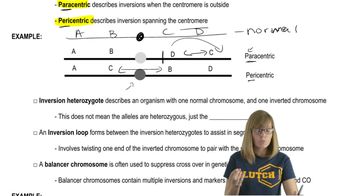Table of contents
- 1. Introduction to Genetics51m
- 2. Mendel's Laws of Inheritance3h 37m
- 3. Extensions to Mendelian Inheritance2h 41m
- 4. Genetic Mapping and Linkage2h 28m
- 5. Genetics of Bacteria and Viruses1h 21m
- 6. Chromosomal Variation1h 48m
- 7. DNA and Chromosome Structure56m
- 8. DNA Replication1h 10m
- 9. Mitosis and Meiosis1h 34m
- 10. Transcription1h 0m
- 11. Translation58m
- 12. Gene Regulation in Prokaryotes1h 19m
- 13. Gene Regulation in Eukaryotes44m
- 14. Genetic Control of Development44m
- 15. Genomes and Genomics1h 50m
- 16. Transposable Elements47m
- 17. Mutation, Repair, and Recombination1h 6m
- 18. Molecular Genetic Tools19m
- 19. Cancer Genetics29m
- 20. Quantitative Genetics1h 26m
- 21. Population Genetics50m
- 22. Evolutionary Genetics29m
6. Chromosomal Variation
Chromosomal Rearrangements: Inversions
Problem 7
Textbook Question
Textbook QuestionFrom the following list, identify the types of chromosome changes you expect to show phenotypic consequences.
pericentric inversion
 Verified Solution
Verified SolutionThis video solution was recommended by our tutors as helpful for the problem above
Video duration:
3mPlay a video:
Was this helpful?
Key Concepts
Here are the essential concepts you must grasp in order to answer the question correctly.
Chromosome Structure
Chromosomes are structures within cells that contain DNA and proteins. They are essential for the proper segregation of genetic material during cell division. Changes in chromosome structure, such as inversions, can disrupt gene function and regulation, potentially leading to phenotypic changes.
Recommended video:
Guided course

Chromosome Structure
Pericentric Inversion
A pericentric inversion is a type of chromosomal rearrangement where a segment of a chromosome is inverted and includes the centromere. This alteration can affect gene order and expression, leading to potential phenotypic consequences, especially if it disrupts essential genes or regulatory elements.
Recommended video:
Guided course

Inversions
Phenotypic Consequences
Phenotypic consequences refer to observable traits or characteristics that result from genetic changes. When chromosome structure is altered, such as through pericentric inversions, it can lead to variations in phenotype, including developmental abnormalities or changes in physical traits, depending on the genes affected.
Recommended video:
Guided course

Mutations and Phenotypes
Related Videos
Related Practice



